Welcome to the latest selection of recent top articles in the physica status solidi journals. Get a glimpse of our publication spectrum and visit our pages by clicking on any of the DOI links below.
DFT and k ·p modelling of the phase transitions of lead and tin halide perovskites for photovoltaic cells [Rapid Research Letter · rrl solar]
Jacky Even, Laurent Pedesseau, Jean-Marc Jancu, and Claudine Katan
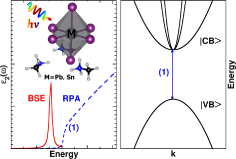 The room temperature optical absorption of 3D hybrid organic perovskites is associated to excitonic transitions between the spin–orbit split-off conduction band and the valence band. Spin–orbit coupling is about three times smaller for tin compounds. Tetragonal distortions are analysed by a k·p perturbation, including spin–orbit effect. In addition, non-centrosymmetric high temperature phases exhibit a splitting of the electronic bands away from the critical point.
The room temperature optical absorption of 3D hybrid organic perovskites is associated to excitonic transitions between the spin–orbit split-off conduction band and the valence band. Spin–orbit coupling is about three times smaller for tin compounds. Tetragonal distortions are analysed by a k·p perturbation, including spin–orbit effect. In addition, non-centrosymmetric high temperature phases exhibit a splitting of the electronic bands away from the critical point.
Phys. Status Solidi RRL (2013) DOI 10.1002/pssr.201308183
Enhanced two-photon luminescence from nanoporous gold capped with microcontact-printed salts [Rapid Research Letter]
Jung-Sub Wi, Joo Hyun Park, Satoshi Tominaka, and Jae Yong Lee
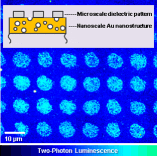 Highly enhanced local electric field strengths at nanoscale pores in the Au film and the additional field increment by introducing the microcontact-printed dielectric patterns make an approximate 40-fold increase in the two-photon luminescence intensity as compared to the bare Au film, showing a great potential for application in biological imaging and diagnosis.
Highly enhanced local electric field strengths at nanoscale pores in the Au film and the additional field increment by introducing the microcontact-printed dielectric patterns make an approximate 40-fold increase in the two-photon luminescence intensity as compared to the bare Au film, showing a great potential for application in biological imaging and diagnosis.
Phys. Status Solidi RRL (2013) DOI 10.1002/pssr.201308208
Towards high efficiency segmented thermoelectric unicouples [Advanced Materials Physics]
Pham Hoang Ngan, Dennis Valbjørn Christensen, Gerald Jeffrey Snyder, Le Thanh Hung, Søren Linderoth, Ngo Van Nong, and Nini Pryds
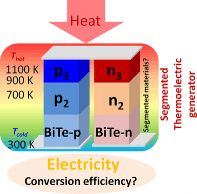 Thermoelectricity, a process of converting heat into electricity and vice versa, is important for its high potential for many applications. Both the conversion efficiency and working temperature range can be greatly improved by segmenting multiple materials. Here, the authors design high-efficient thermoelectric (TE) generators by segmenting today’s state-of-the-art TE materials. Their efficiencies are calculated at temperature spans of up to 1100 K, and the criterion for selecting compatible materials for segmentation is given.
Thermoelectricity, a process of converting heat into electricity and vice versa, is important for its high potential for many applications. Both the conversion efficiency and working temperature range can be greatly improved by segmenting multiple materials. Here, the authors design high-efficient thermoelectric (TE) generators by segmenting today’s state-of-the-art TE materials. Their efficiencies are calculated at temperature spans of up to 1100 K, and the criterion for selecting compatible materials for segmentation is given.
Phys. Status Solidi A (2013) DOI 10.1002/pssa.201330155
Development of gallium oxide power devices [Invited Article]
Masataka Higashiwaki, Kohei Sasaki, Akito Kuramata, Takekazu Masui, and Shigenobu Yamakoshi
 Gallium oxide (Ga2O3) is a strong contender for power electronic devices. The material possesses excellent properties such as a large bandgap of 4.7–4.9 eV for a high breakdown field of 8 MV/cm. The authors fabricated Ga2O3 metal–semiconductor field-effect transistors (MESFETs) and Schottky barrier diodes (SBDs) from single-crystal Ga2O3 substrates and MBE-grown epitaxial wafers. The MESFETs delivered excellent device performance including an off-state breakdown voltage of over 250 V, a low leakage current of only few mA/mm, and a high drain current on/off ratio of about four orders of magnitude. The SBDs also showed good characteristics such as near-unity ideality factors and high reverse breakdown voltage. These results indicate that Ga2O3 can potentially meet or even exceed the performance of Si and typical wide-gap semiconductors such as SiC or GaN for ultrahigh-voltage power switching applications.
Gallium oxide (Ga2O3) is a strong contender for power electronic devices. The material possesses excellent properties such as a large bandgap of 4.7–4.9 eV for a high breakdown field of 8 MV/cm. The authors fabricated Ga2O3 metal–semiconductor field-effect transistors (MESFETs) and Schottky barrier diodes (SBDs) from single-crystal Ga2O3 substrates and MBE-grown epitaxial wafers. The MESFETs delivered excellent device performance including an off-state breakdown voltage of over 250 V, a low leakage current of only few mA/mm, and a high drain current on/off ratio of about four orders of magnitude. The SBDs also showed good characteristics such as near-unity ideality factors and high reverse breakdown voltage. These results indicate that Ga2O3 can potentially meet or even exceed the performance of Si and typical wide-gap semiconductors such as SiC or GaN for ultrahigh-voltage power switching applications.
Phys. Status Solidi A (2013) DOI 10.1002/pssa.201330197
Raman scattering as a tool to characterize semiconductor crystals, thin layers, and low-dimensional structures containing transition metals [Feature Article]
W. Szuszkiewicz, M. Jouanne, J.-F. Morhange, M. Kanehisa, E. Dynowska, K. Gas, E. Janik, G. Karczewski, R. Kuna, and T. Wojtowicz
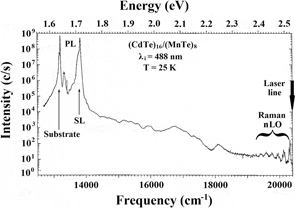 Raman scattering is well known as an efficient, nondestructive experimental method to study a variety of physical properties of semiconductors. In this Feature Article, the sensitivity of modern Raman spectroscopy is illustrated by results obtained for semiconductor bulk crystals, thin layers or low-dimensional structures containing selected transition metals. Among the examples of Raman scattering data the detection of precipitates, a study of the influence of strain on phonon and magnon frequencies, and the search for magnetic excitations and for new phenomena characteristic of low-dimensional structures are described.
Raman scattering is well known as an efficient, nondestructive experimental method to study a variety of physical properties of semiconductors. In this Feature Article, the sensitivity of modern Raman spectroscopy is illustrated by results obtained for semiconductor bulk crystals, thin layers or low-dimensional structures containing selected transition metals. Among the examples of Raman scattering data the detection of precipitates, a study of the influence of strain on phonon and magnon frequencies, and the search for magnetic excitations and for new phenomena characteristic of low-dimensional structures are described.
Phys. Status Solidi B (2013) DOI 10.1002/pssb.201350142
Pressure–composition phase diagram of Ti–C from first-principles [Original Paper]
Chao Jiang and Wensen Jiang
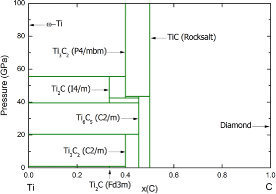 In this paper the authors report a theoretical prediction of the zero-temperature pressure–composition phase diagram for the binary Ti–C system using ab initio evolutionary methodology. The ground-state search successfully identifies the known stable Ti2C, Ti3C2, Ti6C5 and TiC structures at 0 GPa. The study uncovers two new titanium carbides that are thermodynamically stable at high pressures: tetragonal Ti2C with I4/m symmetry and tetragonal Ti3C2 with P4/mbm symmetry. Both carbides are quenchable to ambient pressure and remain mechanically stable, and are potential candidates for hard materials. The I4/m and P4/mbm structures are also expected to be stable in the isoelectronic Zr–C and Hf–C systems at high pressures. Experimental synthesis of these novel carbides will be of great interest.
In this paper the authors report a theoretical prediction of the zero-temperature pressure–composition phase diagram for the binary Ti–C system using ab initio evolutionary methodology. The ground-state search successfully identifies the known stable Ti2C, Ti3C2, Ti6C5 and TiC structures at 0 GPa. The study uncovers two new titanium carbides that are thermodynamically stable at high pressures: tetragonal Ti2C with I4/m symmetry and tetragonal Ti3C2 with P4/mbm symmetry. Both carbides are quenchable to ambient pressure and remain mechanically stable, and are potential candidates for hard materials. The I4/m and P4/mbm structures are also expected to be stable in the isoelectronic Zr–C and Hf–C systems at high pressures. Experimental synthesis of these novel carbides will be of great interest.
Phys. Status Solidi B (2013) DOI 10.1002/pssb.201350209

















